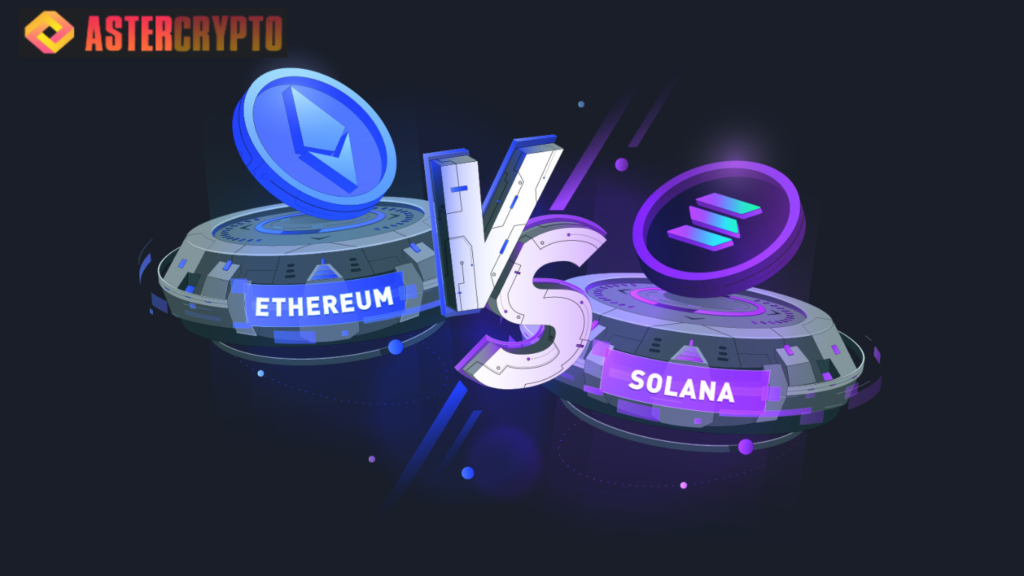Non-fungible tokens, or NFTs, are unique digital items that people can buy and sell. You might find NFTs in the form of art, music, or even virtual pets. Two popular blockchains for minting (creating) NFTs are Ethereum and Solana. In this article, we’ll compare the two to help you decide which one is better for your NFT projects.
Ethereum: Marketplace, Ecosystem, and Security
In the decentralized finance (DeFi) space, Ethereum is without a doubt the largest ecosystem, hosting hundreds of projects of various kinds. It follows that the great majority of non-fungible tokens (NFTs) function on Ethereum as ERC-721 tokens, which is not surprising. Ethereum is the preferred option for investors looking for NFT marketplaces like OpenSea, Rarible, and Nifty Gateway, as it is utilized by around 95% of the NFT ecosystem.
Ethereum leads in terms of size, having a significantly bigger pool of buyers and sellers, which results in higher trading volumes. Minting NFTs on an Ethereum-based exchange like OpenSea can increase visibility and draw in more bids or buyers. It’s crucial to remember that this high level of activity also brings with it an abundance of NFTs that can have trouble finding buyers.
A comprehensive tutorial is offered to make the process of minting one’s first NFT on OpenSea easier for anybody wishing to do so.
Etheeum’s Distinctive Features
Ethereum is a desirable platform for starting DeFi projects because of its architecture and security characteristics. But more network activity frequently results in large backlogs of transactions, which raises transaction fees and discourages users from minting NFTs. Because of this, developers and collectors are now looking into alternative blockchains that have less gas costs and greater scalability.
Solana, a high-performance blockchain that boosts its network capabilities through various cryptographic techniques, is one of its most prominent rivals. Ethereum’s strong financial environment allows for larger transactions and revenues, even though high gas prices can be a hardship. According to data from CryptoSlam, in the previous 30 days, Ethereum has sold almost $1.8 billion worth of goods, compared to $120 million from Solana-based markets.
According to recent data, the most well-known NFT collections—CryptoPunks, the Bored Ape Yacht Club (BAYC), and the Mutant Ape Yacht Club (MAYC)—are available on the Ethereum blockchain. As of Q4 2021, the average sale price of NFTs on Ethereum was over $3,000, and the average on Solana was roughly $1,000.
Solana: Throughput, Low Fees, Growing Ecosystem

In terms of functionality and technology, Solana is becoming a top blockchain. It makes use of the Proof-of-History consensus mechanism, which enables high throughput—processing more than 60,000 transactions per second (TPS). Because Solana’s transaction costs are usually less than $1, it’s a desirable choice for NFT projects and collectors looking for reduced fees and scalability. The ability to develop projects without being constrained by technological issues is highly valued by users, establishing Solana as a growing hub for NFTs.
Minting NFTs on a marketplace like Solsea, which is situated in Solana, is an inexpensive and effective way to generate quick sales on the secondary market. As a matter of fact, royalties in Solana marketplaces are typically larger than in Ethereum markets, and Solana mints are frequently purchased swiftly.
Read More: 11 Best Non-Custodial Crypto Wallets in 2024
Even though Solana has a smaller ecosystem than Ethereum, since early 2022, its user base has been growing quickly. JP Morgan analysts have even gone so far as to say that Solana may eventually outperform Ethereum in the long run. The NFT market in Solana had grown significantly by January 2023, with sales volume surpassing $1 billion.
With 10,000 distinct NFT Apes, Solana’s Degenerate Ape Academy is one of its most well-liked NFT collections. They bear resemblance to Ethereum’s Bored Apes, but they also possess unique characteristics. In September 2021, a Degen Ape sold for the highest price ever of $1.1 million, while in mid-December, an NFT from the Solana Monkey Business series sold for more over 13,000 SOL, or roughly $2 million.
Early adopters of Solana have the chance to establish themselves ahead of wider adoption, much like in any growing ecosystem. But there are risks involved as well. The Solana network has experienced multiple failures, which has forced users to liquidate their holdings because they were unable to manage their collateral during the outages.
Concerns have also been raised by the growth in rug pulls, a sort of swindle in which developers abandon a project after receiving money. Due diligence is essential before investing in NFTs or DeFi initiatives, as these dangers are present in both the Ethereum and Solana ecosystems.

Ethereum VS Solana
Strengths of Ethereum
- Large User Base: Many people and developers use Ethereum, making it a reliable choice.
- Popular Marketplaces: Well-known platforms like OpenSea and Rarible work on Ethereum, giving creators access to many buyers.
- Active Community: Ethereum has a strong community that helps improve the network and support creators.
Weaknesses of Ethereum
- High Fees: The cost to mint and trade NFTs on Ethereum can be high, especially during busy times.
- Slower Transactions: Sometimes, transactions can take longer because of network congestion.
Strengths of Solana
- Low Fees: Minting NFTs on Solana usually costs less than $0.01, making it very affordable.
- Fast Transactions: Solana can process thousands of transactions every second, allowing quick minting and trading.
- Growing Ecosystem: Although it is newer, Solana has several NFT marketplaces, like Solanart and Magic Eden.
Weaknesses of Solana
- Less Established: Being new, Solana has fewer users and projects compared to Ethereum.
- Smaller Community: The community is still growing, so there may be fewer resources available.
Comparing Transaction Fees
Transaction fees are one of the most important things to consider when minting NFTs.
- Ethereum: Fees can be high, sometimes reaching $50 or more during busy times. This can make it expensive to create multiple NFTs.
- Solana: The fees on Solana are usually less than $0.01, making it very cheap to mint and trade NFTs.
Conclusion:
The decision between Ethereum and Solana ultimately comes down to personal preferences and objectives. For those in need of a scalable, high-throughput blockchain with affordable gas costs, Solana might be a better choice.

Solana
Pros:
- Greater scalability and throughput.
- expanding ecosystem.
- Cheap gas prices and a greener world.
- Simple and inexpensive NFT minting.
Cons:
- Less safe network.
- less exposure because the market is smaller.
- more frequent pauses.
- Ethereum, however, might be a better option if you’re searching for exposure to a bigger market with robust security measures.
Ethereum
Pros:
Increased market reach.
enhanced security for networks.
On average, NFTs sell for significantly more money.
Cons:
Transaction delays may result from network congestion.
Reduced scalability and throughput.
For many users who want to mint NFTs, transaction costs can become unaffordable.

